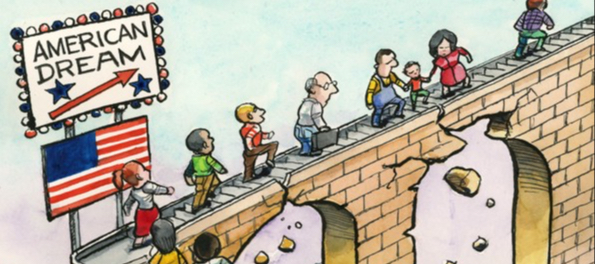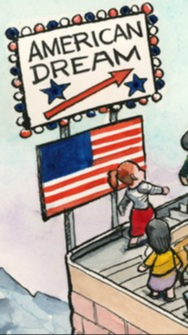Capitalism in America was once defined by innovation, competition, risk, and reward. The premise was simple: build a better product and the market rewards you. Make a critical mistake and you face the consequences. That principle governed the landscape—until the rules were rewritten by the most powerful players in the system.
Today, we live under the doctrine of "Too Big to Fail". A phrase that has come to represent a modern version of divine right in the marketplace. It signifies that if a corporation is large enough, influential enough, or well-connected enough, it is shielded from the consequences of failure.
While small businesses and individuals still face the unforgiving reality of the market, the corporate giants operate under a system more akin to tailored socialism.
Bailouts by Design
This is not a theoretical shift. It is a demonstrable pattern. Boeing is a prime example—but it is far from alone. Companies like AIG, General Motors, and Silicon Valley Bank have all collapsed under their own mismanagement only to be rescued by taxpayer-funded interventions.
Boeing: The Corporate Collapse That Should Have Ended Differently
Once the crown jewel of American aviation, Boeing was known for engineering excellence and national pride. It built the iconic 747, contributed to defense efforts, and shaped global air travel. Then profit began to eclipse principle—as it so often happens with greedy people.
In 2018 and 2019, two Boeing 737 MAX aircraft crashed, killing 346 people. The cause was a faulty software system—MCAS—designed to compensate for design flaws in a rushed response to competition from Airbus. Boeing was aware of the risks. It concealed them from regulators and the public. It undermined whistleblowers and lobbied aggressively to protect its interests.
The result was a global grounding of the MAX, multiple investigations, and more than $20 billion in costs. Under normal market rules, Boeing would have collapsed. But Boeing is not a typical company—it is a major defense contractor and a critical component of the U.S. economy.
When the COVID-19 pandemic hit in 2020, the aviation industry plummeted. Boeing was already vulnerable and began seeking support. It requested $60 billion in federal aid and received a $17 billion package through the CARES Act, designated for firms deemed critical to national security.
Boeing gained access to low-interest loans and government bond markets. The Federal Reserve began buying corporate debt to stabilize the sector. Boeing even declined loans that would have given the government equity—opting instead for private financing with the assurance that the Fed would maintain favorable market conditions.
This was not just financial assistance. It was a systemic reconfiguration to ensure Boeing’s survival.
AIG and the 2008 Financial Collapse
The 2008 financial crisis revealed the dangers of unchecked risk and moral hazard. AIG, a firm that sold insurance on financial products it scarcely understood, became one of the epicenters of the collapse. Having issued trillions in credit default swaps, AIG found itself liable for debts it could not cover.
Unlike Lehman Brothers, which was allowed to fail, AIG received a bailout totaling $182 billion because its collapse threatened the entire financial system. Its counterparties—including Goldman Sachs and Deutsche Bank—were repaid in full using public funds.
AIG eventually repaid the government after downsizing significantly, but the message was clear: capitalism was suspended in favor of systemic preservation.
General Motors: Too Legacy to Die
Another example of this was General Motors. This company—long seen as a pillar of American industry—had by the 2000s become an unwieldy enterprise burdened by bureaucracy and legacy costs. When the financial crisis hit, GM collapsed and filed for bankruptcy.
The federal government intervened with $50 billion, creating a “New GM” and taking a controlling stake. The restructured company later went public, and the government exited at a financial loss. While thousands of workers and dealerships were sacrificed, the company itself was salvaged.
Silicon Valley Bank: Fragile by Design
In 2023, Silicon Valley Bank collapsed under the weight of rising interest rates, poor risk strategy, and heavy exposure to long-term Treasury bonds. The bank’s failure triggered panic among startups and venture capital firms that relied on it.
While shareholders and investors were wiped out, the FDIC stepped in to guarantee all deposits—including those far above the insured limit. This was framed as a stabilization measure rather than a bailout, but the result was similar: a key institution was preserved at public expense to prevent broader disruption.
The Rise of Corporate Feudalism
This pattern of government protection for large corporations stems from deeper systemic shifts. Market consolidation, regulatory capture, and financial engineering have redefined American capitalism.
Four firms control most of the meatpacking industry. Technology is dominated by a few giants such as Google, Amazon, Meta, and Apple. Investment powerhouses like BlackRock and Vanguard hold significant stakes in nearly every major U.S. company.
The result is not a free market—but a form of corporate feudalism, where dominant players do not compete as much as they entrench their positions while public institutions serve as guarantors of their permanence.
The Era of Death Capitalism
We have entered a phase where companies are no longer sustained by competitiveness or innovation—but by intervention. The Federal Reserve has artificially supported financial markets through prolonged low interest rates, allowing many firms that cannot cover their debt obligations to continue operating.
These “zombie companies” now constitute a significant portion of the economy. When they falter, markets panic—and public institutions respond with more support to avoid collapse.
The principle of creative destruction is a cornerstone of capitalism. Yet it has been replaced by a system that discourages failure at the top while maintaining harsh consequences for those without influence.
A Two-Tiered System Disguised as Capitalism
No company is inherently too big to fail. But many are too politically entangled, too structurally important, and too embedded in our financial systems to be allowed to fail.
Boeing produces vital military equipment. AIG was the linchpin of Wall Street. GM employed hundreds of thousands. SVB served as the financial backbone for the innovation sector.
These firms were not rescued because they earned redemption—but because their failure would have disrupted the status quo.
The Call to Restore True Capitalism
What has emerged is a bifurcated economic reality. True capitalism governs small enterprises and individuals, while powerful corporations enjoy state protection.
To restore integrity to the system, structural changes are essential:
- Break up monopolies
- Enforce antitrust laws
- Reintroduce real consequences for corporate failure
Only when risk applies equally across the spectrum will capitalism regain its legitimacy and function as it was intended.
If we don’t wake up to change the system ourselves by caring enough to act, nothing can change.


